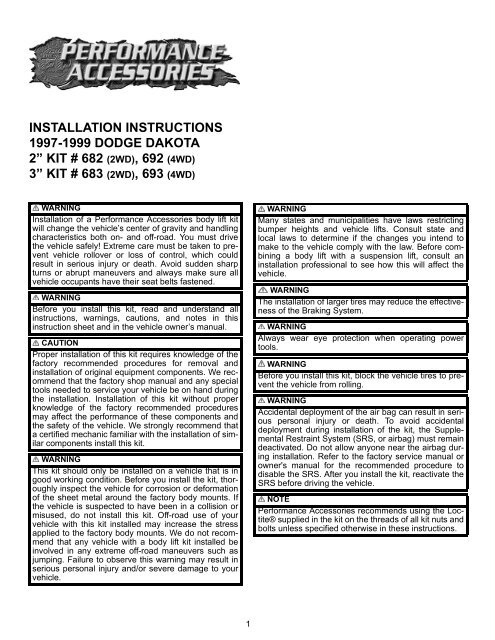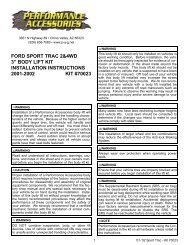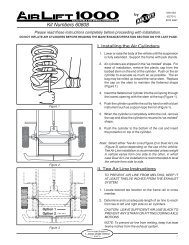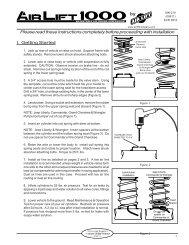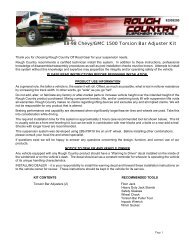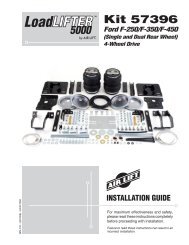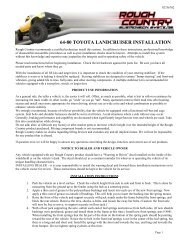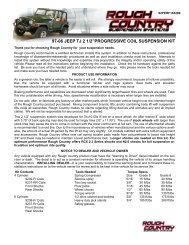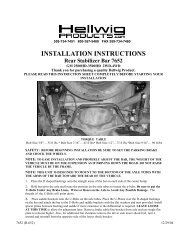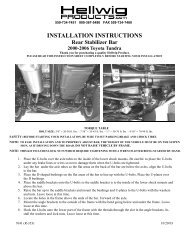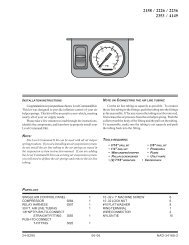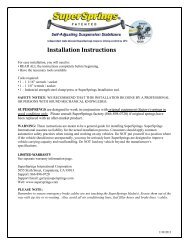INSTALLATION INSTRUCTIONS 1997-1999 DODGE DAKOTA 2 ...
INSTALLATION INSTRUCTIONS 1997-1999 DODGE DAKOTA 2 ...
INSTALLATION INSTRUCTIONS 1997-1999 DODGE DAKOTA 2 ...
Create successful ePaper yourself
Turn your PDF publications into a flip-book with our unique Google optimized e-Paper software.
<strong>INSTALLATION</strong> <strong>INSTRUCTIONS</strong><br />
<strong>1997</strong>-<strong>1999</strong> <strong>DODGE</strong> <strong>DAKOTA</strong><br />
2” KIT # 682 (2WD), 692 (4WD)<br />
3” KIT # 683 (2WD), 693 (4WD)<br />
WARNING<br />
Installation of a Performance Accessories body lift kit<br />
will change the vehicle’s center of gravity and handling<br />
characteristics both on- and off-road. You must drive<br />
the vehicle safely! Extreme care must be taken to prevent<br />
vehicle rollover or loss of control, which could<br />
result in serious injury or death. Avoid sudden sharp<br />
turns or abrupt maneuvers and always make sure all<br />
vehicle occupants have their seat belts fastened.<br />
WARNING<br />
Before you install this kit, read and understand all<br />
instructions, warnings, cautions, and notes in this<br />
instruction sheet and in the vehicle owner’s manual.<br />
CAUTION<br />
Proper installation of this kit requires knowledge of the<br />
factory recommended procedures for removal and<br />
installation of original equipment components. We recommend<br />
that the factory shop manual and any special<br />
tools needed to service your vehicle be on hand during<br />
the installation. Installation of this kit without proper<br />
knowledge of the factory recommended procedures<br />
may affect the performance of these components and<br />
the safety of the vehicle. We strongly recommend that<br />
a certified mechanic familiar with the installation of similar<br />
components install this kit.<br />
WARNING<br />
This kit should only be installed on a vehicle that is in<br />
good working condition. Before you install the kit, thoroughly<br />
inspect the vehicle for corrosion or deformation<br />
of the sheet metal around the factory body mounts. If<br />
the vehicle is suspected to have been in a collision or<br />
misused, do not install this kit. Off-road use of your<br />
vehicle with this kit installed may increase the stress<br />
applied to the factory body mounts. We do not recommend<br />
that any vehicle with a body lift kit installed be<br />
involved in any extreme off-road maneuvers such as<br />
jumping. Failure to observe this warning may result in<br />
serious personal injury and/or severe damage to your<br />
vehicle.<br />
WARNING<br />
Many states and municipalities have laws restricting<br />
bumper heights and vehicle lifts. Consult state and<br />
local laws to determine if the changes you intend to<br />
make to the vehicle comply with the law. Before combining<br />
a body lift with a suspension lift, consult an<br />
installation professional to see how this will affect the<br />
vehicle.<br />
WARNING<br />
The installation of larger tires may reduce the effectiveness<br />
of the Braking System.<br />
WARNING<br />
Always wear eye protection when operating power<br />
tools.<br />
WARNING<br />
Before you install this kit, block the vehicle tires to prevent<br />
the vehicle from rolling.<br />
WARNING<br />
Accidental deployment of the air bag can result in serious<br />
personal injury or death. To avoid accidental<br />
deployment during installation of the kit, the Supplemental<br />
Restraint System (SRS, or airbag) must remain<br />
deactivated. Do not allow anyone near the airbag during<br />
installation. Refer to the factory service manual or<br />
owner's manual for the recommended procedure to<br />
disable the SRS. After you install the kit, reactivate the<br />
SRS before driving the vehicle.<br />
NOTE<br />
Performance Accessories recommends using the Loctite®<br />
supplied in the kit on the threads of all kit nuts and<br />
bolts unless specified otherwise in these instructions.<br />
1
I. Before starting installation<br />
NOTE<br />
You will find it easier to keep track of fasteners if immediately<br />
after you remove them you put them in a paper<br />
bag and write on the bag which parts they go with.<br />
a. Remove airbag fuses from fuse box. The location<br />
of airbag fuses may vary; check the owner's<br />
manual.<br />
Cover<br />
1. Special tools needed<br />
a. Welder or access to a professional welding shop<br />
2. Read all warnings and instructions completely and<br />
carefully before you begin.<br />
3. Check to make sure the kit is complete (refer to the<br />
Kit Parts List at the end of this document).<br />
4. Only install this kit on the vehicle for which it is<br />
intended. During installation, if you encounter something<br />
different from what is outlined in the instructions,<br />
call technical support at (928) 636-7080.<br />
5. Park vehicle on a clean, dry, flat, level surface and<br />
block tires so vehicle cannot roll in either direction.<br />
A. Engine compartment<br />
1. Battery cables<br />
a. Disconnect the negative cable first, then the<br />
positive cable from the battery.<br />
B. Inside cab<br />
1. Airbag fuses<br />
Airbag Fuses<br />
II. Prepare to install kit<br />
A. Front of vehicle<br />
1. Front bumper<br />
a. Measure and record distance between front<br />
bumper and fenders.<br />
Driver Side _____Passenger Side _____<br />
b. Vehicles with fog lights: Disconnect wire connectors<br />
from fog lights.<br />
c. Remove four bolts holding bumper to frame.<br />
Remove bumper.<br />
d. Remove cover from below radiator (attached to<br />
bumper and core support).<br />
B. Engine compartment<br />
1. Fan shroud<br />
a. Remove wire loom mounting tabs from bottom of<br />
core support. Remove four bolts holding fan<br />
shroud to radiator. Allow fan shroud to rest<br />
against engine.<br />
2 <strong>1997</strong>-99 Dodge Dakota - Kits 682, 683, 692, 693
2. Ground wires<br />
a. Check routing of ground wire at firewall, near<br />
brake booster. If ground wire is routed over<br />
brake booster, check to be sure there is ample<br />
slack in ground wire. If necessary, reroute<br />
ground wire under brake booster.<br />
b. At driver side frame rail, behind front wheel,<br />
loosen bolt holding ground wire to frame. Rotate<br />
ground wire to gain slack for lifting cab. Tighten<br />
bolt.<br />
3. Wire loom<br />
Bolt<br />
b. Mark axis of steering shaft U-joint in relation to<br />
axis of steering rack (or steering gearbox on<br />
4WD vehicles).<br />
Steering<br />
Shaft<br />
U-Joint<br />
a. At driver side frame rail, behind front wheel,<br />
remove wire loom mounting tab from top of<br />
frame.<br />
Alignment Marks<br />
Steering Gearbox<br />
4. Brake lines<br />
a. Detach brake lines from plastic clips holding<br />
lines together. When you lift cab, watch these<br />
lines carefully to ensure they are not kinked. It<br />
may be necessary to bend lines to gain slack.<br />
5. Manual transmission: Clutch fluid line<br />
a. Check hydraulic clutch fluid line to be sure there<br />
is ample slack for lifting. It may be necessary to<br />
remove line from mounting clip.<br />
6. Automatic transmission: Shift cable<br />
a. Remove automatic transmission shift cable from<br />
clip on driver side inner fender.<br />
7. Steering shaft<br />
WARNING<br />
Accidental deployment of the air bag can result in serious<br />
personal injury or death. To avoid accidental<br />
deployment during installation of the lift kit, the Supplemental<br />
Restraint System (SRS, or airbag) must remain<br />
deactivated. Do not allow anyone near the airbag during<br />
installation. Refer to the factory service manual or<br />
owner's manual for the recommended procedure to<br />
disable the SRS. After kit installation, the SRS must be<br />
reactivated before driving the vehicle.<br />
CAUTION<br />
If the following step is not performed, the airbag clockspring<br />
could be damaged. Do not turn the steering<br />
wheel while the steering shaft is disconnected.<br />
a. Strap steering wheel to prevent accidental<br />
movement.<br />
c. Remove bolt holding steering shaft U-joint to<br />
steering rack (steering gearbox on 4WD).<br />
d. Disconnect steering shaft U-joint from steering<br />
rack (steering gearbox on 4WD).<br />
C. Inside cab<br />
1. Shift console<br />
a. Manual transmission: Remove upper portion of<br />
transmission shift lever. Remove transmission<br />
shift lever boot.<br />
b. 4WD vehicles: Remove 4WD shift lever knob<br />
and boot.<br />
c. Remove rubber inserts from cup holders in shift<br />
console. Remove three screws holding shift console<br />
to floor.<br />
d. Vehicles with center storage console:<br />
Remove four screws holding center storage console<br />
to floor (they are inside of console).<br />
e. Gently pull front of shift console upward until<br />
clips are released.<br />
f. Remove screws holding shift console to floor.<br />
Remove shift console.<br />
g. Remove rubber boot from top of transmission.<br />
h. Push cover down, rotate shift lever to release it,<br />
and remove shift lever.<br />
3 <strong>1997</strong>-99 Dodge Dakota - Kits 682, 683, 692, 693
2. 4WD vehicles: Transfer case shift lever<br />
a. Remove four bolts and skid plate from under<br />
transmission and transfer case.<br />
b. Disconnect transfer case shift linkage rod from<br />
transfer case input lever.<br />
c. Remove two bolts and transfer case shift lever<br />
assembly from side of transmission.<br />
D. Fuel filler<br />
2. Rear bumper<br />
a. Measure and record distance between rear<br />
bumper and bed/tailgate.<br />
Driver Side _____Passenger Side _____<br />
b. Disconnect wire harnesses from license plate<br />
lights.<br />
c. Remove six bolts holding rear bumper to frame<br />
and remove rear bumper.<br />
1. Fuel filler and vent hoses<br />
a. Disconnect fuel filler hose and vent hose from<br />
fuel tank. (These are “quick connect” style couplers.<br />
Push collar toward tank and pull hose off.)<br />
E. Rear of vehicle<br />
1. Spare tire<br />
a. Lower spare tire to ground.<br />
b. Remove clip holding crank rod to winch mechanism.<br />
Remove crank rod.<br />
c. Remove plastic collar from crank rod hole in<br />
body. The collar will be relocated.<br />
III. Install kit<br />
A. Cab<br />
1. Prepare to lift cab from frame.<br />
a. Measure and record distance between cab and<br />
bed.<br />
Driver Side _____Passenger Side _____<br />
b. Loosen, but DO NOT remove, cab mounting<br />
bolts on driver side (three bolts on vehicles with<br />
regular cab; four bolts on vehicles with extended<br />
or crew cab).<br />
Loosen bolt<br />
at these mounts<br />
Core Support<br />
Cab Mount<br />
(Core Support)<br />
Cab Mount<br />
(Except Core Support)<br />
4 <strong>1997</strong>-99 Dodge Dakota - Kits 682, 683, 692, 693
c. Remove bolt and lower bushing from each cab<br />
mount on passenger side.<br />
Bolt<br />
Lower Bushing<br />
Remove bolt<br />
from these mounts<br />
b. Install a kit block on upper bushing at each cab<br />
mount:<br />
• Block, 2” height x 3” diameter (2” kit)<br />
• Block, 3” height x 3” diameter (3” kit)<br />
Kit Lift Block<br />
Upper Bushing<br />
Cab Mount<br />
Cab Mount<br />
c. Lower cab onto kit blocks.<br />
WARNING<br />
Use extreme caution when lifting body from frame. To<br />
prevent serious personal injury, ensure the lifting<br />
device is securely placed. Keep your hands out from<br />
between the body and frame.<br />
CAUTION<br />
To prevent damage to the vehicle while lifting the cab,<br />
continually check hoses, wires, brake lines, etc. to<br />
ensure everything is flexing properly and not binding.<br />
Ensure clearance between bed and cab is maintained.<br />
d. Install lower bushing and a kit bolt on each cab<br />
mount. DO NOT tighten:<br />
• Bolt, 12mm x 140mm (2” kit)<br />
• Bolt, 12mm x 160mm (3” kit)<br />
Lower Bushing<br />
2. Cab passenger side<br />
a. Using a hydraulic jack and a wooden block,<br />
slowly lift passenger side of cab just enough to<br />
position a kit block between cab mount upper<br />
bushing and cab.<br />
WARNING<br />
The kit lift blocks must be installed in addition to the<br />
factory upper and lower bushings. Installing the kit lift<br />
blocks without the factory upper and lower bushings<br />
could result in damage to the vehicle or serious personal<br />
injury.<br />
Kit Bolt<br />
3. Cab driver side<br />
Cab Mount<br />
a. Repeat previous steps on driver side of cab.<br />
4. Finish cab mounting to frame.<br />
a. Set cab-to-bed spacing according to previous<br />
measurement.<br />
5 <strong>1997</strong>-99 Dodge Dakota - Kits 682, 683, 692, 693
. Remove each kit bolt, one at a time, and apply a<br />
few drops of Loctite® to threads. Install kit bolt<br />
with kit washer (1/2” SAE). Tighten kit bolt to 55<br />
ft. lbs.<br />
Lower Bushing<br />
Kit Bolt,<br />
Washer (1/2” SAE)<br />
B. Bed<br />
1. Prepare to lift bed from frame.<br />
a. Loosen, but DO NOT remove, bed mounting<br />
bolts on driver side (three bolts on vehicles with<br />
short bed; four bolts on vehicles with long bed).<br />
Loosen bolt<br />
at these mounts<br />
WARNING<br />
Use extreme caution when lifting the bed from the<br />
frame. To prevent serious personal injury, ensure the<br />
lifting device is securely placed. Keep your hands out<br />
from between the bed and frame.<br />
CAUTION<br />
To prevent damage to the vehicle while lifting the bed,<br />
continually check hoses, wires, brake lines, etc. to<br />
ensure everything is flexing properly and not binding.<br />
Ensure clearance between bed and cab is maintained.<br />
2. Bed passenger side<br />
a. Using a hydraulic jack and a wooden block,<br />
slowly lift passenger side of bed just enough to<br />
position a kit block between bed mount (frame)<br />
and bed.<br />
b. Install a kit block on the frame at mount closest<br />
to rear end of bed:<br />
• Block, 2” height x 2” diameter (2” kit)<br />
• Block, 3” height x 2” diameter (3” kit)<br />
Bolt<br />
Bed Mount (Typical)<br />
b. Remove bolt from each bed mount on passenger<br />
side.<br />
Kit Lift Block<br />
(2" diameter)<br />
c. Install a kit block at other mounts:<br />
• Block, 2” height x 3” diameter (2” kit)<br />
• Block, 3” height x 3” diameter (3” kit)<br />
Remove bolt<br />
from these mounts<br />
Kit Lift Block<br />
(3" diameter)<br />
d. Lower bed onto kit lift blocks.<br />
6 <strong>1997</strong>-99 Dodge Dakota - Kits 682, 683, 692, 693
e. Insert a kit bolt through kit washers (3/8” USS<br />
and 7/16” USS), then install kit bolt at each bed<br />
mount, . DO NOT tighten.<br />
• Bolt, 10mm x 80mm (2” kit)<br />
• Bolt, 10mm x 100mm (3” kit)<br />
3. Bed driver side<br />
a. Repeat previous steps on driver side of bed.<br />
4. Finish bed mounting to frame<br />
NOTE<br />
To raise the rear bumper, new mounting holes must be<br />
drilled in the frame (and in the original bumper brackets<br />
on a 3” kit).<br />
a. Drill 1/2” holes in frame as shown below.<br />
New Hole =<br />
Original Hole =<br />
a. Set cab-to-bed spacing according to previous<br />
measurement.<br />
b. Remove each kit bolt, one at a time, and apply a<br />
few drops of Loctite® to threads. Install kit bolt<br />
with kit washers. Tighten kit bolt to 40 ft. lbs<br />
C. Rear of vehicle<br />
1. Spare tire<br />
a. Remove license plate frame.<br />
2” Kit<br />
2”<br />
2”<br />
2”<br />
Rear End of Frame<br />
New Hole =<br />
Original Hole =<br />
b. Measure down 2” (2” kit) or 3” (3” kit) from<br />
spare tire crank rod hole. Using a hole saw, cut a<br />
new hole.<br />
3”<br />
3”<br />
2”<br />
c. Install plastic collar (from original crank rod hole)<br />
in new hole. It may be necessary to glue plastic<br />
collar in place.<br />
3” Kit<br />
Rear End of Frame<br />
d. Install crank rod through new hole and engage<br />
end of it onto winch mechanism. Secure crank<br />
rod to winch mechanism with original clip.<br />
e. Raise spare tire to stowed position (all the way<br />
up).<br />
f. Install license plate frame.<br />
2. Rear bumper<br />
b. 3” kit: Locate hole in rear bumper bracket that<br />
corresponds to rear hole in frame. Measure<br />
down 1” and drill a 1/2” hole in rear bumper<br />
bracket at that location.<br />
New Hole =<br />
Original Hole =<br />
1”<br />
WARNING<br />
The following procedure for raising the rear bumper is<br />
intended to enhance the appearance of the vehicle<br />
only. The rear bumper will no longer be rated for towing<br />
of any kind. Any attempt to tow with the rear<br />
bumper after it has been lifted can result in damage to<br />
the vehicle and possible personal injury. Any towing<br />
that is done after the bumper has been lifted should<br />
only be done with a rated class III receiver type hitch. If<br />
you wish to tow with the bumper after the body lift kit<br />
has been installed, reinstall the rear bumper in its original<br />
location using the original hardware.<br />
3” Kit<br />
Rear Bumper Bracket<br />
c. All kits: Set rear bumper into position.<br />
d. Insert a kit bolt (7/16” x 1 1/2”) through a kit<br />
washer (7/16” USS), then install kit bolt through<br />
rearmost hole from inside of frame.<br />
7 <strong>1997</strong>-99 Dodge Dakota - Kits 682, 683, 692, 693
e. Install a kit washer (7/16” USS) and kit nut<br />
(7/16” nylock) on kit bolt.<br />
f. Apply Loctite® to threads of bolts that originally<br />
held bumper to frame. Install original bolts in forward<br />
two holes from inside of frame. Install original<br />
nuts.<br />
g. Adjust bumper to bed/tailgate clearance, then<br />
tighten all bumper mounting bolts.<br />
h. Connect wire connectors to license plate lights.<br />
D. Fuel filler<br />
1. Fuel filler and vent hoses<br />
a. Connect fuel filler hose and vent hose to fuel<br />
tank. (Ensure “quick connect” couplers lock into<br />
place. It may seem like hoses are being<br />
stretched, but there is enough slack.)<br />
E. Engine compartment<br />
1. Steering shaft<br />
a. Install kit steering extension on input shaft of<br />
steering rack (steering gearbox on 4WD vehicles).<br />
It should only go on one way.<br />
b. Install (DO NOT tighten) kit bolt (3/8” x 1 1/4”,<br />
socket head) in kit steering extension. Be sure<br />
kit bolt crosses recessed area of input shaft.<br />
This will prevent separation of kit steering<br />
extension from input shaft.<br />
c. Try to pull kit steering extension off of input<br />
shaft. If kit steering extension comes off, it has<br />
not been installed correctly. Reinstall it.<br />
F. Inside cab<br />
1. Manual transmission: Shift lever<br />
a. Place bottom portion of shift lever in a vise. Heat<br />
shift lever at the bend, then bend it forward<br />
about 1/2”.<br />
b. Install bottom portion of shift lever into transmission.<br />
Turn cover and lock it into place.<br />
c. Install upper portion of shift lever in lower portion<br />
of shift lever. Be sure boot is in place. Tighten<br />
securely. Install plastic cover.<br />
d. Check operation of shift lever. Be sure transmission<br />
engages fully in all gears.<br />
G. Engine compartment<br />
1. Automatic transmission: Shift cable<br />
a. Be sure shift cable is not interfering with anything<br />
in engine compartment. No further modifications<br />
should be required.<br />
H. Bench work<br />
NOTE<br />
A certified welder should perform all welding.<br />
1. 4WD vehicles: Transfer case shift lever<br />
a. Remove plastic insert from shift lever positioning<br />
bracket.<br />
b. Scribe a line along axis of shift lever, between<br />
top of positioning bracket and the bend in shift<br />
lever.<br />
d. Install steering shaft on kit steering extension.<br />
e. Install original bolt in steering shaft. Be sure original<br />
bolt crosses recessed area of kit steering<br />
extension. This will prevent separation of steering<br />
shaft from kit steering extension.<br />
Scribed Line<br />
Cut<br />
Here<br />
Kit Pin<br />
f. Try to pull steering shaft off of kit steering<br />
extension. If kit steering extension comes off,<br />
it has not been installed correctly. Reinstall it.<br />
g. Apply Loctite® to threads of kit bolt and original<br />
bolt, then tighten to 33 ft. lbs.<br />
8 <strong>1997</strong>-99 Dodge Dakota - Kits 682, 683, 692, 693
c. Cut shift lever into two pieces in middle of line.<br />
d. To prevent heat damage while welding, insulate<br />
rest of shift mechanism.<br />
e. Align two halves of scribed lines, then weld kit<br />
pin between two parts of shift lever:<br />
• Pin, 1/2” x 2” (2” kit)<br />
• Pin, 1/2” x 3” (3” kit)<br />
f. After welds cool, install plastic insert.<br />
a. If positive battery cable will not reach battery,<br />
disconnect cable mounting bracket at frame.<br />
Use a kit cable tie to secure battery cable to<br />
power steering hose.<br />
3. Automatic transmission: Fan shroud<br />
a. Cut lower mounting tab off of passenger side of<br />
fan shroud. Be careful not to damage hoses or<br />
lines nearby.<br />
g. Place shift lever in a vise. Heat and bend shift<br />
lever back about 1/4” This will help the transfer<br />
case engage in 2H.<br />
I. Underside of vehicle<br />
1. 4WD vehicles: Transfer case shift lever assembly<br />
a. Install shift lever assembly on side of transmission<br />
using original bolts.<br />
b. Connect linkage rod to transfer case. Tighten<br />
nut.<br />
c. Install boot over shift lever. Because shift lever<br />
has been lengthened, the throw is now longer. It<br />
may be necessary to glue boot into place in<br />
order to keep it from moving around.<br />
d. Shift transfer case into 4L. If shift lever is hitting<br />
plastic console, loosen adjusting nut on transfer<br />
case linkage rod. Adjust linkage so lever can be<br />
placed securely in 4L, but will not be too far forward<br />
to stay in 2H. Tighten adjusting bolt.<br />
e. Install shift knob, mounting screw, and cap.<br />
f. Install skid plate under vehicle.<br />
J. Engine compartment<br />
1. Brake lines<br />
Fan Shroud<br />
Automatic Transmission<br />
Cut Off Mounting Tab<br />
(Passenger Side)<br />
b. Using three bolts that originally held fan shroud<br />
to radiator, install three kit brackets (“L”-shaped)<br />
on radiator in all locations except lower passenger<br />
side (where you removed mounting tab).<br />
c. Install fan shroud on studs of kit brackets. Install<br />
a kit washer (1/4” SAE) and kit nut (1/4” nylock)<br />
on each stud.<br />
d. Check fan to fan shroud clearance. Tighten fan<br />
shroud fasteners.<br />
e. Using remaining bolt that originally held fan<br />
shroud to radiator, install kit bracket (“L”<br />
shaped) on lower passenger side of radiator.<br />
Using hole in kit bracket (“L” shaped) as a template,<br />
mark fan shroud. Remove kit bracket (“L”<br />
shaped). Using a 1/4” drill, drill a hole in fan<br />
shroud where marked.<br />
a. At driver side inner fender, check brake lines that<br />
you removed from clips. If necessary, bend lines<br />
to gain more slack. Be extremely careful not to<br />
kink lines.<br />
2. Positive battery cable<br />
Fan Shroud<br />
Automatic<br />
Transmission<br />
Drill 1/4”<br />
Hole<br />
Removed Mounting Tab<br />
(Passenger Side)<br />
9 <strong>1997</strong>-99 Dodge Dakota - Kits 682, 683, 692, 693
f. Install kit bracket (“L”-shaped) on radiator. Insert<br />
a kit bolt (1/4” x 1”) through a kit washer (1/4”<br />
SAE). From inside of fan shroud, insert kit bolt<br />
(1/4” x 1”) through 1/4” hole you drilled, a kit<br />
washer (1/4” SAE), and kit bracket (“L”-<br />
shaped). Install a kit nut (1/4” nylock) on kit bolt<br />
(1/4” x 1”).<br />
g. Check fan to fan shroud clearance. Tighten fan<br />
shroud fasteners.<br />
h. Drill a 1/4” hole in bottom center of fan shroud<br />
(to install kit wire loom). Secure wire harness to<br />
bottom of fan shroud with a kit wire loom, a kit<br />
bolt (1/4” x 1”), kit washers (1/4” SAE), and a kit<br />
nut (1/4” nylock).<br />
i. Use kit zip ties to secure wire harness to outside<br />
edges of fan shroud (possibly to core support).<br />
Be sure that wire harness cannot contact fan or<br />
any other moving parts.<br />
4. Manual transmission: Fan shroud<br />
a. Install four kit brackets (“L”-shaped) on radiator<br />
using four bolts that originally held fan shroud to<br />
radiator.<br />
b. Install fan shroud on studs of kit brackets. Install<br />
a kit washer (1/4” SAE) and kit nut (1/4” nylock)<br />
on each stud.<br />
c. Check fan to fan shroud clearance. Tighten fan<br />
shroud fasteners.<br />
K. Front of vehicle<br />
1. 2” kit: Front bumper<br />
a. Using original front bumper mounting hardware,<br />
install kit brackets (front bumper inner) on inside<br />
mounts. The “C” of kit bracket should be open to<br />
rear of vehicle. Center the kit brackets on each<br />
mount. Apply Loctite® to bolt threads. Tighten<br />
bolts.<br />
b. Remove outer support brackets from front<br />
bumper. (On each side of vehicle, two Torx head<br />
screws fasten brackets to bumper.) Separate<br />
two pieces of outer support brackets.<br />
c. Install kit bracket (front bumper outer) behind<br />
two pieces of outer support bracket. Install a kit<br />
bolt (7/16” x 1”) in top hole of kit bracket and top<br />
slot in original bumper mounted plate.<br />
2” Kit<br />
d. Install original bolts in bottom two holes in kit<br />
bracket (front bumper outer), then in original<br />
holes in bottom portion of original bracket. The<br />
top original bolts should go into bottom slot on<br />
top bracket. Install nuts on original bolts. Snug<br />
all bolts, but do not tighten. The brackets will<br />
need to be adjusted after bumper has been<br />
installed.<br />
e. Install assembly on bumper using original torx<br />
screws. Tighten torx screws securely.<br />
f. Install bumper on kit brackets (front bumper<br />
inner) using four kit bolts (7/16” x 1 1/2”), eight<br />
kit washers (7/16” USS), and four kit nuts (7/16”<br />
nylock). Do not tighten.<br />
g. Using original bolts, install outer support brackets<br />
on frame.<br />
h. Adjust clearance between bumper and fenders<br />
as recorded earlier.<br />
i. Tighten bolts: Remove each bumper bolt one at<br />
a time, apply Loctite® to threads, install, and<br />
tighten.<br />
j. Connect any wire harnesses that were disconnected.<br />
2. 3” kit: Front bumper<br />
Kit Bracket<br />
(Front Bumper Outer)<br />
a. Using original front bumper mounting hardware,<br />
install kit brackets (front bumper inner) on inside<br />
mounts. The “C” of kit bracket should be open to<br />
rear of vehicle. Center the kit brackets on each<br />
mount. Apply Loctite® to bolt threads. Tighten<br />
bolts.<br />
b. Remove outer support brackets from front<br />
bumper. (On each side of vehicle, two Torx head<br />
screws fasten brackets to bumper.) Separate<br />
two pieces of outer support brackets.<br />
10 <strong>1997</strong>-99 Dodge Dakota - Kits 682, 683, 692, 693
c. Locate slot in plate that attaches to bumper. Drill<br />
a 1/2” hole about 11/16” below this slot.<br />
d. Install kit bracket (front bumper outer) behind<br />
two pieces of outer support bracket. Install a kit<br />
bolt (7/16” x 1”) in top hole of kit bracket and top<br />
slot in original bumper mounted plate.<br />
2. Weld kit crush blocks to frame.<br />
Bed Cross-Channel<br />
3” Kit<br />
Kit Bracket<br />
(Front Bumper<br />
Outer)<br />
Kit Crush Block<br />
(Bed Spacer)<br />
Weld<br />
Frame<br />
e. Install original bolts in bottom two holes in kit<br />
bracket (front bumper outer), then in original<br />
holes in bottom portion of original bracket. The<br />
top original bolts should go into new hole in top<br />
bracket. Install nut on bottom bolt.<br />
f. Grind washer on remaining nut flat so it can<br />
clear edge of top bracket.<br />
g. Snug all bolts, but do not tighten. The brackets<br />
will need to be adjusted after bumper has been<br />
installed. Install assembly on bumper using original<br />
Torx screws.<br />
h. Install bumper on kit brackets (front bumper<br />
inner) using four kit bolts (7/16” x 1 1/2”), eight<br />
kit washers (7/16” USS), and four kit nuts (7/16”<br />
nylock). Do not tighten.<br />
IV. After completing installation<br />
A. Inside cab<br />
1. Airbag fuses<br />
a. Install airbag fuses in fuse box. The location of<br />
airbag fuses may vary; check the owner's manual.<br />
Cover<br />
i. Using original bolts, install outer support brackets<br />
on frame.<br />
j. Adjust clearance between bumper and fenders<br />
as recorded earlier.<br />
k. Remove each bumper bolt one at a time, apply<br />
Loctite® to threads, install, and tighten.<br />
l. Connect any wire harnesses that were disconnected.<br />
Airbag Fuses<br />
L. Crush blocks (bed spacers)<br />
1. Set four kit crush blocks (bed spacers) in place on<br />
frame below bed cross-channels.<br />
B. Engine compartment<br />
1. Battery cables<br />
a. Connect both battery cables. Be sure to connect<br />
the positive cable first, then the negative cable.<br />
11 <strong>1997</strong>-99 Dodge Dakota - Kits 682, 683, 692, 693
C. Warning label<br />
1. Install kit label (warning) on vehicle dash in plain<br />
sight of all vehicle occupants.<br />
D. Vehicle check<br />
1. Check all hoses, cables, wires, a/c lines, trans<br />
cooler lines, etc. to be sure there is ample slack.<br />
2. Check clearance between fan and fan shroud. Be<br />
sure fan does not contact fan shroud. Check hydraulic<br />
clutch line. Be sure there is ample slack in line.<br />
Check clutch operation.<br />
3. Start vehicle. Check all vehicle systems for proper<br />
operation. Test drive in all gears and 4WD ranges.<br />
Ensure the transfer case shift lever will stay in gear.<br />
It may require further adjustment.<br />
4. Double check all fasteners in 500 miles and as part<br />
of your regular maintenance schedule.<br />
Rev. 02 Copyright 05/04 Performance Accessories<br />
Kit Parts List<br />
Qty.<br />
Kits 682/692<br />
Description<br />
2 Block, lift, 2" height x 2” diameter<br />
12 Block, lift, 2" height x 3” diameter<br />
8 Bolt, 10mm x 80mm<br />
6 Bolt, 12mm x 140mm<br />
1 Pin, 4WD shift lever extension (1/2” x 2”)<br />
Kits 683/693<br />
2 Block, lift, 3” height x 2” diameter<br />
12 Block, lift, 3” height x 3” diameter<br />
8 Bolt, 10mm x 100mm<br />
6 Bolt, 12mm x 160mm<br />
1 Pin, 4WD shift lever extension (1/2” x 3“)<br />
All kits<br />
4 Block, crush (bed spacer), metal<br />
2 Bolt, 1/4” x 1”<br />
1 Bolt, 3/8” x 1 1/4”, socket head<br />
2 Bolt, 7/16” x 1”<br />
6 Bolt, 7/16” x 1 1/2”<br />
1 Bracket, fan shroud-to-radiator (“L”-shaped) (1)<br />
4 Bracket, fan shroud-to-radiator (studded)<br />
2 Bracket, front bumper inner<br />
2 Bracket, front bumper outer<br />
1 Bracket, wire loom<br />
1 Label, logo<br />
1 Label, warning<br />
1 Loctite®, 6ml tube<br />
5 Nut, 1/4” nylock<br />
8 Nut, 7/16” nylock<br />
1 Steering extension<br />
7 Washer, 1/4” SAE<br />
8 Washer, 3/8” USS<br />
4 Washer, 7/16” SAE<br />
20 Washer, 7/16” USS<br />
6 Washer, 1/2” SAE<br />
3 Zip tie<br />
(1) - Required for automatic transmission only.<br />
12 <strong>1997</strong>-99 Dodge Dakota - Kits 682, 683, 692, 693


